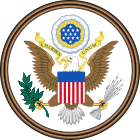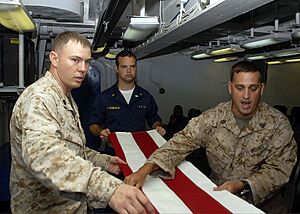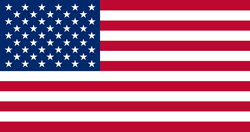United States Flag Code facts for kids
 |
|
| Long title | An Act to revise, codify, and enact without substantive change certain general and permanent laws, related to patriotic and national observances, ceremonies, and organizations, as title 36, United States Code, ‘‘Patriotic and National Observances, Ceremonies, and Organizations’’. |
|---|---|
| Enacted by | the 105th United States Congress |
| Effective | August 12, 1998 |
| Citations | |
| Public law | Pub.L. 105-225 |
| Statutes at Large | 112 Stat. 1498 |
| Codification | |
| Acts amended | 56 Stat. 378, chapter 435; 36 U.S.C. 175 |
| Titles amended | Title 4 of the United States Code |
| U.S.C. sections created | 4 U.S.C. ch. 5 § 5 |
| Legislative history | |
|
|
The United States Flag Code is a set of helpful rules for how to show respect to the American flag. It tells people how to display the flag and how to take care of it. This code is part of Title 4 of the United States Code, which is a collection of U.S. laws.
It's important to know that these rules are mostly suggestions. The code uses words like "should" and "custom," meaning you won't get in trouble if you don't follow every single guideline.
There was once another law, called the Flag Protection Act, which tried to stop people from damaging or burning the flag. However, the Supreme Court of the United States later decided that this law was against the U.S. Constitution, so it can't be enforced anymore.
The same law that includes the Flag Code also gives advice on what to do when the U.S. National Anthem is playing, especially if the flag is nearby. It suggests that people should face the flag, stand tall (at attention), and place their hand over their heart.
Contents
What Defines the U.S. Flag?
The U.S. Flag is officially defined by law and special government rules. This helps make sure all American flags look the same.
A special order from the President, called Executive Order 10834, describes the flag's design. It also sets the correct sizes and where the stars should be placed.
Important Rules for Displaying the Flag
The Flag Code gives many suggestions for how to treat the American flag with respect. These are advisory rules, meaning they are good practices to follow.
- The flag should never be lowered (or "dipped") to salute any person or object. The only exception is when a U.S. Navy ship's flag (called an ensign) salutes a foreign ship's flag.
- If a flag becomes very old or torn, it should be replaced. The best way to retire an old flag is by burning it in a respectful ceremony. Groups like the Veterans of Foreign Wars and the Boy Scouts of America often hold these ceremonies.
- The flag should never be used to hold, carry, or deliver anything.
- The flag should never touch the ground or anything below it.
- The flag should not be used as clothing, bedding, or curtains. It should always hang freely, not gathered or tied back.
- The flag should never be carried flat or horizontally.
- The flag should never be used for advertising.
- Nothing should be placed on the flag, like letters, pictures, or designs.
- The flag should never be flown upside down, unless it's a sign of extreme danger or distress.
- When the flag is hung vertically on a wall, the blue section with the stars (called the "union") should be on the observer’s left side.
Flag Etiquette and the National Anthem
While the Flag Code itself focuses on the flag, other parts of the same law give advice on how to act during the National Anthem. This helps show respect for both the anthem and the flag.
When the National Anthem is played:
- If the flag is displayed, everyone should face the flag. They should stand tall (at attention) with their right hand over their heart.
- If the flag is not displayed, everyone should face the music. They should act the same way as if the flag were displayed.
History of the Flag Code
How the Flag Code Started
Before 1923, there were no official rules for displaying the U.S. flag. On Flag Day, June 14, 1923, many groups came together. They created the first National Flag Code. The American Legion helped share these rules across the country.
On June 22, 1942, this code became a federal law. Not much changed from the original 1923 rules. One important change was removing the Bellamy salute. This salute was too similar to the Hitler salute used by the Nazis.
Recent Changes to Flag Laws
The Freedom to Display the American Flag Act of 2005 was passed to protect people's right to show the American flag. This law stops housing groups from preventing homeowners from displaying the flag on their own property.
In 2007, a new rule was added to the Flag Code. This rule, called the Army Specialist Greg L. Chambers Federal Flag Code Amendment Act, allows state governors or the mayor of Washington D.C. to order flags to be flown at half-staff. This happens when a member of the U.S. Armed Forces from their area dies while serving.
Another change in 2009, part of the Duncan Hunter National Defense Authorization Act, allowed military members not in uniform and veterans to salute the flag during the National Anthem.




